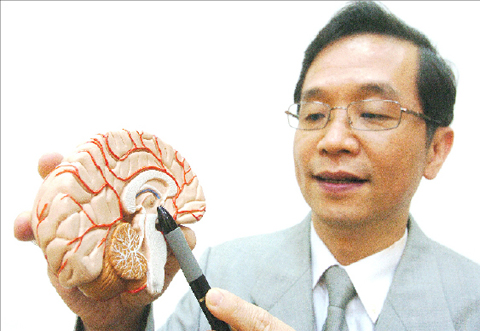The unemployment rate rose to a new high of 5.81 percent last month as more companies closed their doors or laid off workers to cope with the economic downturn, the Directorate-General of Budget, Accounting and Statistics (DGBAS) said yesterday.
On a more optimistic note, however, the statistics agency said some industries appeared to have hit bottom.
The headline unemployment rate gained 0.06 percentage points to 5.81 percent, or 630,000 people, last month, the highest level since DGBAS initiated the survey 31 years ago, the agency’s monthly report showed.

PHOTO: CHANG CHIA-MING, TAIPEI TIMES
The seasonally adjusted index increased 0.09 percentage points to 5.72 percent, higher than forecasts by UBS and Citigroup Taiwan Inc. The two banks put the rate at 5.6 percent.
“The labor market remains tough,” DGBAS Deputy Director Huang Jiann-jong (黃建中) told a media briefing. “While the unemployment rate continued rising in March, the rise slackened to a seven-month low.”
An additional 15,000 people lost their jobs in business closures or downsizing last month, Huang said, adding that the number of people working less than 16 hours a week had dropped by 27,000 amid a rush of orders from China.
The unemployment rate would have reached 6.21 percent if the government had not added 890,000 contract workers to its payroll, bringing employees in the public sector to 1.04 million, the report said.
The broad unemployment rate was 7.4 percent, up from 7.32 percent a month earlier, if non-workers such as students and housewives were included, the report said.
People aged between 45 and 64 accounted for 141,000 unemployed — an increase of 56,000, or 66 percent, from a year ago — the highest increase among all age groups, Huang said, calling attention to their predicament as many are breadwinners.
The official said the unemployment pointer would head higher in coming months when college graduates are expected to enter the market, starting next month.
“It would be better to look at the figure after seasonal adjustment,” Huang said. “The issue is not so grave if the index remains stable.”
Kevin Hsiao (蕭正義), head of UBS Wealth Management Research in Taiwan, said college graduates would have difficulty finding jobs this year.
“The economy is not expected to turn the corner until the fourth quarter and firms will not hire new workers in the absence of a robust recovery,” Hsiao said by telephone.
Polaris Research Institute (寶華綜合經究院) president Liang Kuo-yuan (梁國源) said the job market contracted for 22 months during the last downturn and that losses would be heavier losses this time around, given the severity of the crisis.
In a related development, the nominal take-home salary averaged NT$35,314 (US$1,044) per month in February, up from NT$35,130 in January, ending a downward trend in the previous four months, DGBAS said in a separate report yesterday.
However, the figures shrank by 12.13 percent in the first two months, if bonuses and dividends were also factored in, the report said.

Taiwan’s long-term economic competitiveness will hinge not only on national champions like Taiwan Semiconductor Manufacturing Co. (TSMC, 台積電) but also on the widespread adoption of artificial intelligence (AI) and other emerging technologies, a US-based scholar has said. At a lecture in Taipei on Tuesday, Jeffrey Ding, assistant professor of political science at the George Washington University and author of "Technology and the Rise of Great Powers," argued that historical experience shows that general-purpose technologies (GPTs) — such as electricity, computers and now AI — shape long-term economic advantages through their diffusion across the broader economy. "What really matters is not who pioneers

In a high-security Shenzhen laboratory, Chinese scientists have built what Washington has spent years trying to prevent: a prototype of a machine capable of producing the cutting-edge semiconductor chips that power artificial intelligence (AI), smartphones and weapons central to Western military dominance, Reuters has learned. Completed early this year and undergoing testing, the prototype fills nearly an entire factory floor. It was built by a team of former engineers from Dutch semiconductor giant ASML who reverse-engineered the company’s extreme ultraviolet lithography (EUV) machines, according to two people with knowledge of the project. EUV machines sit at the heart of a technological Cold

TAIWAN VALUE CHAIN: Foxtron is to fully own Luxgen following the transaction and it plans to launch a new electric model, the Foxtron Bria, in Taiwan next year Yulon Motor Co (裕隆汽車) yesterday said that its board of directors approved the disposal of its electric vehicle (EV) unit, Luxgen Motor Co (納智捷汽車), to Foxtron Vehicle Technologies Co (鴻華先進) for NT$787.6 million (US$24.98 million). Foxtron, a half-half joint venture between Yulon affiliate Hua-Chuang Automobile Information Technical Center Co (華創車電) and Hon Hai Precision Industry Co (鴻海精密), expects to wrap up the deal in the first quarter of next year. Foxtron would fully own Luxgen following the transaction, including five car distributing companies, outlets and all employees. The deal is subject to the approval of the Fair Trade Commission, Foxtron said. “Foxtron will be

Taiwan Semiconductor Manufacturing Co (TSMC, 台積電) last week recorded an increase in the number of shareholders to the highest in almost eight months, despite its share price falling 3.38 percent from the previous week, Taiwan Stock Exchange data released on Saturday showed. As of Friday, TSMC had 1.88 million shareholders, the most since the week of April 25 and an increase of 31,870 from the previous week, the data showed. The number of shareholders jumped despite a drop of NT$50 (US$1.59), or 3.38 percent, in TSMC’s share price from a week earlier to NT$1,430, as investors took profits from their earlier gains